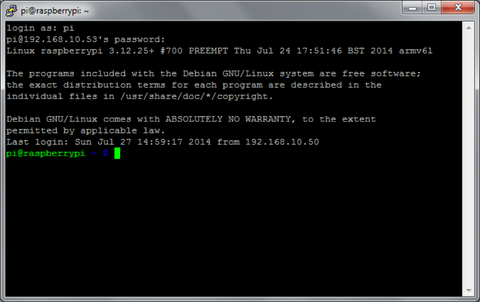
How to remotely access your NavPi StakeBox
If you intend on running your NavPi StakeBox as a standalone device in the future without the need for access to the command line interface through a HDMI TV/Monitor, then this section will show you how to remotely access your StakeBox.
The Raspberry Pi, at the heart of StakeBox has Wi-Fi and Ethernet network capabilities and as such we are able to remotely login to the Raspberry Pi command line from another computer on the same network. First you will need to connect to your local Wi-Fi or Ethernet router.
Connecting to your Internet
Before we start configuring the NavPi StakeBox we must first make sure that we have an internet connection in order to download the blockchain and start staking. There are currently two options with the NavPi StakeBox; firstly you can connect and Ethernet cable from your router/switch or you can connect to your local Wi-Fi router using the built-in Wi-Fi.
Wi-Fi
To connect to your wireless router follow these steps:
- When your StakeBox boots into the NavPi desktop you will see a menu bar in the upper right hand side.

- Here you should see an icon with two red crosses on it, which indicates that the Wi-Fi is not connected to a wireless router. Click on this icon and you should see a list of available Wi-Fi hotspots, where you should see the name of your local router.

- Click on the name of your local hotspot and then enter your Wi-Fi password to connect to it. Note: your Wi-Fi SSID and password can usually be found on the back of your router or in the manual.

- Once you have connected you should see the Wi-Fi icon change and if you hover your mouse of it you will see your IP address and other information about the wireless connection
Ethernet
Ethernet is as simple as connecting an Ethernet cable from your StakeBox to the back of your router, you should see a green light on the Ethernet port on your StakeBox to indicate that it has successfully connected. For Ethernet DHCP settings you will need to refer to your instruction manual for your router.
SSH
SSH is a network protocol that allows you to remotely access another device and issue commands in the command line, just like you would if you were sat in front of that terminal. By default SSH is already installed for you on your StakeBox, all you need to do is enable it.
To enable SSH on your StakeBox follow these steps:
-
Enter
sudo raspi-configin a terminal window - Select Interfacing Options

- Navigate to and select SSH

- Choose Yes

- Select OK
- Choose Finish
Alternatively, you can use systemctl to start the service from the command line:
sudo systemctl enable sshsudo systemctl start sshYou may have noticed a warning message when you have logged in to the Raspberry Pi stating that the default password has NOT been changed and this is a security risk. To change the default password, you can type the following in the terminal window:
passwd Follow the on-screen prompts to change the password.
You will also be required to add the SSH port number to the StakeBox firewall to allow access. You can do this by typing in the following command:
sudo ufw allow 22Setup your SSH client on your computer
You can use SSH client on almost any operating system including the following:
- Linux/Mac OS
- Windows
- iOS
- Android
Linux/Mac OS Client
You can use SSH to connect to your StakeBox from a Linux computer, a Mac, or another StakeBox, without installing additional software, making it much easier to use than other operating systems.
You will need to know your Raspberry Pi's IP address to connect to it. To find this, type ifocnfig wlan0 or ifconfig eth0 from your Raspberry Pi terminal. Next to inet you should see your IP address.

If you are running the StakeBox without a screen (headless), you can also look at the device list on your router. To connect to your StakeBox from a different computer, copy and paste the following command into the terminal window but replace 0.0.0.0 with the IP address of your StakeBox
ssh pi@0.0.0.0If you receive a connection timed out error, it is likely that you have entered the wrong IP address for the Raspberry Pi.
When the connection works you will see a security/authenticity warning. Type yes to continue. You will only see this warning the first time you connect.

In the event your StakeBox has taken the IP address of a device to which your computer has connected before (even if this was on another network), you may be given a warning and asked to clear the record from your list of known devices. You can simply type in the following to clear the device replacing the IP address with that of the StakeBox:
ssh-keygen -R 192.168.0.23Next you will be prompted for the password for the StakeBox login: on Raspbian OS the default password is raspberry, unless you have changed it in the previous section. You should now be able to see the Raspberry Pi OS prompt, which will be identical to the one found on the StakeBox when you boot it up.

If you have set up another user on your StakeBox, you can connect to it in the same way, replacing the username with your own, e.g. chris@192.168.0.2

You are now connected to the StakeBox remotely, and can execute commands from the command line.
Windows Client
On Windows you will need to download an SSH client. The most commonly used client is called PuTTY, and can be downloaded from greenend.org.uk
Look for putty.exe under the heading for Windows on Intel x86.
- Add your StakeBox as a host
PuTTY does not include an installer package: it is a stand-alone .exe file. When you run it, you will see the configuration screen below:

Type the IP address of your StakeBox into the Host Name field and click the Open button. If nothing happens when you click the Open button, and you eventually see a message saying Network error: Connection timed out, it is likely that you have entered the wrong IP address for the StakeBox.
If you do not know the IP address, type hostname -I in the Raspberry Pi command line.
- Connect
When the connection works you will see the security warning shown below. You can safely ignore it, and click the 'Yes' button. You will only see this warning the first time PuTTY connects to a Raspberry Pi that it has not seen before.

You will now see the usual login prompt. Login with the same username and password you would use on the StakeBox itself. The default login for Raspbian OS is pi with the password raspberry.
You should now have the Raspbian OS prompt, which will be identical to the one found on the StakeBox.

You can type exit to close the PuTTY window.
